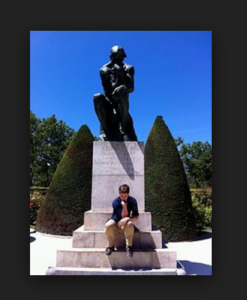Many people believe that creativity is simply an inborn ability. Hence, it is often taken for granted. Many artists complain that inspiration has left them as if their artistry depends on a mystical muse who awakens the gift of creation in them. Do you want to become a thought provoking idea generator? Stay tuned, and we will tell you how.

All this muse culture is very poetic, but not very motivational. Think about it: when you consider that somebody else is responsible for you, you are more likely to use this belief as an excuse to procrastinate. Or maybe even take comfort in mediocrity.
This goes for intelligence too; however, people seem to be more aware that intelligence is a muscle. A muscle which needs to be exercised through research, reading and other cognitive activities.
How can you boost them, then? Let me recommend some principles that work for me:
Build a system of ideas
Anyone can have an idea or two. You only need a few at first. The most important thing is their cohesion, which is the way they are linked. If they are strongly bounded and headed towards a common goal, it will be easier to summon new ones.
It is like you are building up a puzzle. You already have some connectors from the incomplete interconnected pieces; therefore, you already know where to begin from when it comes to finding new pieces(elaborating new ideas).
Do you know that feeling when you are not hungry, but you start to eat, and as you do it, your appetite increases? It is the same thing, because thinking of ideas in a self-contained field establishes a sort of attraction mechanism between them, generating new ones.
Thought provoking … remove blockages
Acknowledge that there’s no such thing as a muse who has left you. The lack of inspiration is a pragmatic reality. Circumstantial. Has it been a long time since you wrote that last poem of yours? Think about the changes that took place in your life. Perhaps your work environment became more stressful, and you are compelled to think in certain patterns.
Or maybe somebody criticized you in a harsh manner, and you are starting to doubt yourself. There also might be certain problems in your family, which push down creativity as a purpose on the list of your priorities. All these can easily get in the way of our creative process. That is why you need to take the initiative, by analyzing your situation and acting according to what is best for your creative mind.
If you are a creative person, creativity doesn’t simply disappear. Fortunately, after the removal of the disruptive factors, we usually return to our initial innovative state.

Organize yourself
Forgetting an idea is a crime. If you don’t feel sorry about losing an idea, it’s even worse.
Whatever you do, wherever you are, when a good idea comes to mind, write it down. Use a notebook or a voice recorder, ignore the people who stare at you on the street or use your phone, pretending that you’re talking to someone, while you record your idea. Don’t hesitate to wake up in the middle of the night only to take notes.
Afterward, organize your ideas on your computer. Structure them on files and folders, create hierarchies and prioritize them according to their importance, role causality, etc.
Research how the brain functions
Does it filter sensory information? Is it possible to optimize the process with a creative purpose?
http://www.northwestern.edu/news…
Sensations are a great way to ground your mind into the artistic universe you are about to create, so add that sensorial authenticity to your creative process. This will enable your ideas to become more vivid. Live in the present moment. Awareness grants you more information to work on, for you to generate new content in return.
Have an open mind

But In a purposeful and positive manner.
Drawing on my experience, the only way you can achieve your desired outcomes is to use more of the powerful real estate lobed between your two ears:
So, more than 500 years ago, Leonardo da Vinci was right when he said, use all our senses, especially our sense of sight.
Our power of observation depends on it.
I treat books interactively, not passively. I underline I scribble notes all over them (gasp!), I mark pages for future reference, I draw diagrams, I always have a notepad handy if I want to think out an idea in more detail.
When you simply “read” a book you don’t retain all of the concepts and information. When you work with a book and engage your brain, you understand the contents, abstractions, and information, and lay that knowledge down as a foundation for creativity, intelligence, etc. It becomes a dynamic mental asset you can draw on quickly and easily.
After all, the human brain is still the most powerful computer. If you develop the right habits, you can increase its power. More input = more output. More thinking = better thinking (but beware of biases). Of course, GIGA applies (Garbage In Garbage Out), so if you read nothing but airport novels…
If you want to be smart, read books written by smart people. And think, hard, about what you’re reading.
Always keep your mind active
If you’re taking a bath, don’t read off the shampoo bottle, think of a new brand of shampoo, try to improve the toilet seat, compose a piece of rhythm by turning on and off the tap water. Just as we have control over our body, take control of your mind as well. If your mind wants to wander off, give it a destination to wander to.
Innovation is creativity with a purpose
So once you exercise your mind and make it create connections between the less obvious, give those creations a purpose. So be curious. Learn everything you can, but not in a schoolish, academic kind of way. Just let your mind remember whatever it likes. But, most importantly, don’t settle for the information you have just because you can live with it.
You don’t even know what you don’t know
So if you want to innovate, you have to know what those before you already know. But don’t let that build walls around you. This is where those connections come in. Have fun with them. See where they take you.
Learn to make mistakes
Stop getting angry when something doesn’t pan out. We have been bred by schools and other restrictive environments so that failure is the worst thing that can happen in a creative process. But it makes you humble; it shows you’re in uncharted territory, which is perfect. Doing something no one else did means there’s hard work involved. So don’t get scared if you fail, get ridiculed or hit walls.
Share sketching and note taking
Over his lifetime Da Vinci created 13,000 pages of sketches and notes. 13,000 pages. By hand, on individual sheets of paper. A sketch in the center, simple and done quickly, the label on top, annotations along the sides, arrows pointing to key content. Sometimes a summary on the bottom.
Divergent thinking first
Alone for the first few iterations divergent thinking. Time to generate lots of ideas, and to reflect. Incubate ideas. Ask himself lots of questions. Always observing and studying. Think about the age of Da Vinci … no computers, few books, and few experts in fields of his interests. Just his ability to see and observe using notes to record for further study.
Convergent thinking later
Da Vinci often reviewed his work with respected peers after he had finished incubating his ideas. It was an opportunity to refine his ideas. Time to collaborate. He was way ahead of his time on most topics, so many of his good ideas were rejected. He didn’t lose his desire or his persistence by the rejections. But remember … 13,000 sketches led to at least three masterpieces. Persistence is a key, isn’t it? Perhaps this is the most important reason we have less creative people.
Save and revisit later
Most of Da Vinci’s sketches were done on individual sheets of paper. Not in a constrained notebook. He understood the value of multiple revisits and connecting, reconnecting, and grouping related facts and observations. An analogy expert. And an uncanny ability to connect several different observations and ideas to create new ideas.
Curiosity and questions
Perhaps Da Vinci’s greatest asset was his insatiable curiosity. The more observations and connection of ideas, the more questions, and curiosity. And creative ideas.